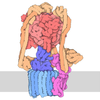+ データを開く
データを開く
- 基本情報
基本情報
| 登録情報 | データベース: PDB / ID: 6ly8 | |||||||||||||||||||||||||||
|---|---|---|---|---|---|---|---|---|---|---|---|---|---|---|---|---|---|---|---|---|---|---|---|---|---|---|---|---|
| タイトル | V/A-ATPase from Thermus thermophilus, the soluble domain, including V1, d, two EG stalks, and N-terminal domain of a-subunit. | |||||||||||||||||||||||||||
 要素 要素 |
| |||||||||||||||||||||||||||
 キーワード キーワード | MOTOR PROTEIN / rotary ATPase / V/A-ATPase / molecular motor | |||||||||||||||||||||||||||
| 機能・相同性 |  機能・相同性情報 機能・相同性情報proton motive force-driven plasma membrane ATP synthesis / proton-transporting ATPase activity, rotational mechanism / H+-transporting two-sector ATPase / proton-transporting ATP synthase complex / proton-transporting ATP synthase activity, rotational mechanism / ATP binding 類似検索 - 分子機能 | |||||||||||||||||||||||||||
| 生物種 |   Thermus thermophilus HB8 (バクテリア) Thermus thermophilus HB8 (バクテリア) | |||||||||||||||||||||||||||
| 手法 | 電子顕微鏡法 / 単粒子再構成法 / クライオ電子顕微鏡法 / 解像度: 3.5 Å | |||||||||||||||||||||||||||
 データ登録者 データ登録者 | Kishikawa, J. / Nakanishi, A. / Furuta, A. / Kato, T. / Namba, K. / Tamakoshi, M. / Mitsuoka, K. / Yokoyama, K. | |||||||||||||||||||||||||||
| 資金援助 |  日本, 3件 日本, 3件
| |||||||||||||||||||||||||||
 引用 引用 |  ジャーナル: Elife / 年: 2020 ジャーナル: Elife / 年: 2020タイトル: Mechanical inhibition of isolated V from V/A-ATPase for proton conductance. 著者: Jun-Ichi Kishikawa / Atsuko Nakanishi / Aya Furuta / Takayuki Kato / Keiichi Namba / Masatada Tamakoshi / Kaoru Mitsuoka / Ken Yokoyama /  要旨: V-ATPase is an energy converting enzyme, coupling ATP hydrolysis/synthesis in the hydrophilic V domain, with proton flow through the V membrane domain, via rotation of the central rotor complex ...V-ATPase is an energy converting enzyme, coupling ATP hydrolysis/synthesis in the hydrophilic V domain, with proton flow through the V membrane domain, via rotation of the central rotor complex relative to the surrounding stator apparatus. Upon dissociation from the V domain, the V domain of the eukaryotic V-ATPase can adopt a physiologically relevant auto-inhibited form in which proton conductance through the V domain is prevented, however the molecular mechanism of this inhibition is not fully understood. Using cryo-electron microscopy, we determined the structure of both the V/A-ATPase and isolated V at near-atomic resolution, respectively. These structures clarify how the isolated V domain adopts the auto-inhibited form and how the complex prevents formation of the inhibited V form. | |||||||||||||||||||||||||||
| 履歴 |
|
- 構造の表示
構造の表示
| ムービー |
 ムービービューア ムービービューア |
|---|---|
| 構造ビューア | 分子:  Molmil Molmil Jmol/JSmol Jmol/JSmol |
- ダウンロードとリンク
ダウンロードとリンク
- ダウンロード
ダウンロード
| PDBx/mmCIF形式 |  6ly8.cif.gz 6ly8.cif.gz | 577.1 KB | 表示 |  PDBx/mmCIF形式 PDBx/mmCIF形式 |
|---|---|---|---|---|
| PDB形式 |  pdb6ly8.ent.gz pdb6ly8.ent.gz | 477.8 KB | 表示 |  PDB形式 PDB形式 |
| PDBx/mmJSON形式 |  6ly8.json.gz 6ly8.json.gz | ツリー表示 |  PDBx/mmJSON形式 PDBx/mmJSON形式 | |
| その他 |  その他のダウンロード その他のダウンロード |
-検証レポート
| 文書・要旨 |  6ly8_validation.pdf.gz 6ly8_validation.pdf.gz | 897.5 KB | 表示 |  wwPDB検証レポート wwPDB検証レポート |
|---|---|---|---|---|
| 文書・詳細版 |  6ly8_full_validation.pdf.gz 6ly8_full_validation.pdf.gz | 951.9 KB | 表示 | |
| XML形式データ |  6ly8_validation.xml.gz 6ly8_validation.xml.gz | 90.5 KB | 表示 | |
| CIF形式データ |  6ly8_validation.cif.gz 6ly8_validation.cif.gz | 144.5 KB | 表示 | |
| アーカイブディレクトリ |  https://data.pdbj.org/pub/pdb/validation_reports/ly/6ly8 https://data.pdbj.org/pub/pdb/validation_reports/ly/6ly8 ftp://data.pdbj.org/pub/pdb/validation_reports/ly/6ly8 ftp://data.pdbj.org/pub/pdb/validation_reports/ly/6ly8 | HTTPS FTP |
-関連構造データ
- リンク
リンク
- 集合体
集合体
| 登録構造単位 | 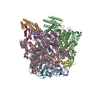
|
|---|---|
| 1 |
|
- 要素
要素
| #1: タンパク質 | 分子量: 63699.980 Da / 分子数: 3 / 由来タイプ: 天然 / 由来: (天然)   Thermus thermophilus HB8 (バクテリア) / 株: HB8 / 参照: UniProt: Q56403, H+-transporting two-sector ATPase Thermus thermophilus HB8 (バクテリア) / 株: HB8 / 参照: UniProt: Q56403, H+-transporting two-sector ATPase#2: タンパク質 | 分子量: 53219.500 Da / 分子数: 3 / 由来タイプ: 天然 / 由来: (天然)   Thermus thermophilus HB8 (バクテリア) / 株: HB8 / 参照: UniProt: Q56404 Thermus thermophilus HB8 (バクテリア) / 株: HB8 / 参照: UniProt: Q56404#3: タンパク質 | | 分子量: 24715.566 Da / 分子数: 1 / 由来タイプ: 天然 / 由来: (天然)   Thermus thermophilus HB8 (バクテリア) / 株: HB8 / 参照: UniProt: O87880 Thermus thermophilus HB8 (バクテリア) / 株: HB8 / 参照: UniProt: O87880#4: タンパク質 | | 分子量: 11294.904 Da / 分子数: 1 / 由来タイプ: 天然 / 由来: (天然)   Thermus thermophilus HB8 (バクテリア) / 株: HB8 / 参照: UniProt: P74903 Thermus thermophilus HB8 (バクテリア) / 株: HB8 / 参照: UniProt: P74903#5: 化合物 | ChemComp-ADP / | 研究の焦点であるリガンドがあるか | N | Has protein modification | N | |
|---|
-実験情報
-実験
| 実験 | 手法: 電子顕微鏡法 |
|---|---|
| EM実験 | 試料の集合状態: PARTICLE / 3次元再構成法: 単粒子再構成法 |
- 試料調製
試料調製
| 構成要素 | 名称: Soluble domain of V/A-ATPase including V1, d, two EG stalks, and N-terminal of a-subunit タイプ: COMPLEX / 詳細: V/A-type ATPase from Thermus thermophilus / Entity ID: #1-#4 / 由来: NATURAL | |||||||||||||||
|---|---|---|---|---|---|---|---|---|---|---|---|---|---|---|---|---|
| 分子量 |
| |||||||||||||||
| 由来(天然) | 生物種:   Thermus thermophilus HB8 (バクテリア) / 株: HB8 Thermus thermophilus HB8 (バクテリア) / 株: HB8 | |||||||||||||||
| 緩衝液 | pH: 8 | |||||||||||||||
| 緩衝液成分 |
| |||||||||||||||
| 試料 | 濃度: 3 mg/ml / 包埋: NO / シャドウイング: NO / 染色: NO / 凍結: YES 詳細: The sample was purified from cell membrane of Thermus thermophilus and incorporated into nanodisc. | |||||||||||||||
| 試料支持 | グリッドの材料: MOLYBDENUM / グリッドのサイズ: 300 divisions/in. / グリッドのタイプ: Quantifoil R1.2/1.3 | |||||||||||||||
| 急速凍結 | 装置: FEI VITROBOT MARK IV / 凍結剤: ETHANE / 湿度: 100 % / 凍結前の試料温度: 277 K |
- 電子顕微鏡撮影
電子顕微鏡撮影
| 実験機器 |  モデル: Titan Krios / 画像提供: FEI Company |
|---|---|
| 顕微鏡 | モデル: FEI TITAN KRIOS |
| 電子銃 | 電子線源:  FIELD EMISSION GUN / 加速電圧: 300 kV / 照射モード: FLOOD BEAM FIELD EMISSION GUN / 加速電圧: 300 kV / 照射モード: FLOOD BEAM |
| 電子レンズ | モード: BRIGHT FIELD / 倍率(公称値): 75000 X / Calibrated defocus min: 2000 nm / 最大 デフォーカス(補正後): 3500 nm / Cs: 2.7 mm |
| 試料ホルダ | 凍結剤: NITROGEN |
| 撮影 | 平均露光時間: 2 sec. / 電子線照射量: 45 e/Å2 / 検出モード: INTEGRATING フィルム・検出器のモデル: FEI FALCON II (4k x 4k) 実像数: 3694 |
| 画像スキャン | 横: 4096 / 縦: 4096 / 動画フレーム数/画像: 34 / 利用したフレーム数/画像: 1-34 |
| EM回折 | カメラ長: 800 mm |
- 解析
解析
| ソフトウェア | 名称: PHENIX / 分類: 精密化 | ||||||||||||||||||||||||||||||||||||
|---|---|---|---|---|---|---|---|---|---|---|---|---|---|---|---|---|---|---|---|---|---|---|---|---|---|---|---|---|---|---|---|---|---|---|---|---|---|
| EMソフトウェア |
| ||||||||||||||||||||||||||||||||||||
| CTF補正 | タイプ: PHASE FLIPPING AND AMPLITUDE CORRECTION | ||||||||||||||||||||||||||||||||||||
| 粒子像の選択 | 選択した粒子像数: 350000 詳細: The particles selected from manually-selected 3084 micrographs. | ||||||||||||||||||||||||||||||||||||
| 対称性 | 点対称性: C1 (非対称) | ||||||||||||||||||||||||||||||||||||
| 3次元再構成 | 解像度: 3.5 Å / 解像度の算出法: FSC 0.143 CUT-OFF / 粒子像の数: 71196 / アルゴリズム: FOURIER SPACE 詳細: Focused classification on the soluble domain was carried out using RELION progarm. 対称性のタイプ: POINT | ||||||||||||||||||||||||||||||||||||
| 原子モデル構築 | プロトコル: FLEXIBLE FIT / 空間: REAL / Target criteria: Correlation coefficient | ||||||||||||||||||||||||||||||||||||
| 原子モデル構築 | PDB-ID: 5Y5Y Accession code: 5Y5Y / Source name: PDB / タイプ: experimental model | ||||||||||||||||||||||||||||||||||||
| 拘束条件 |
|
 ムービー
ムービー コントローラー
コントローラー







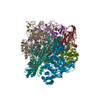
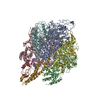
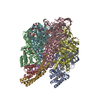
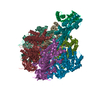
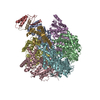
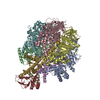

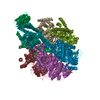
 PDBj
PDBj